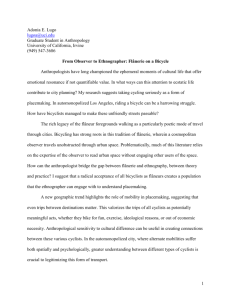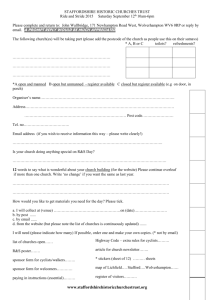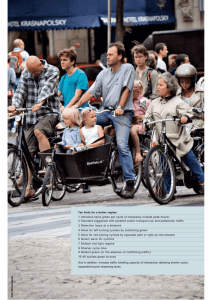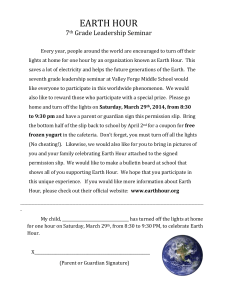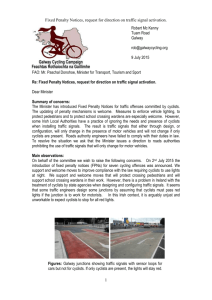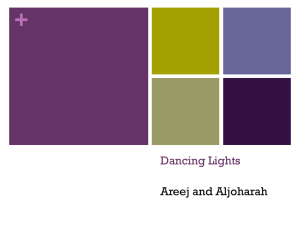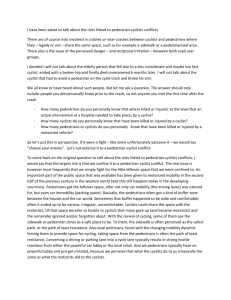The bicycle-friendly traffic light
advertisement
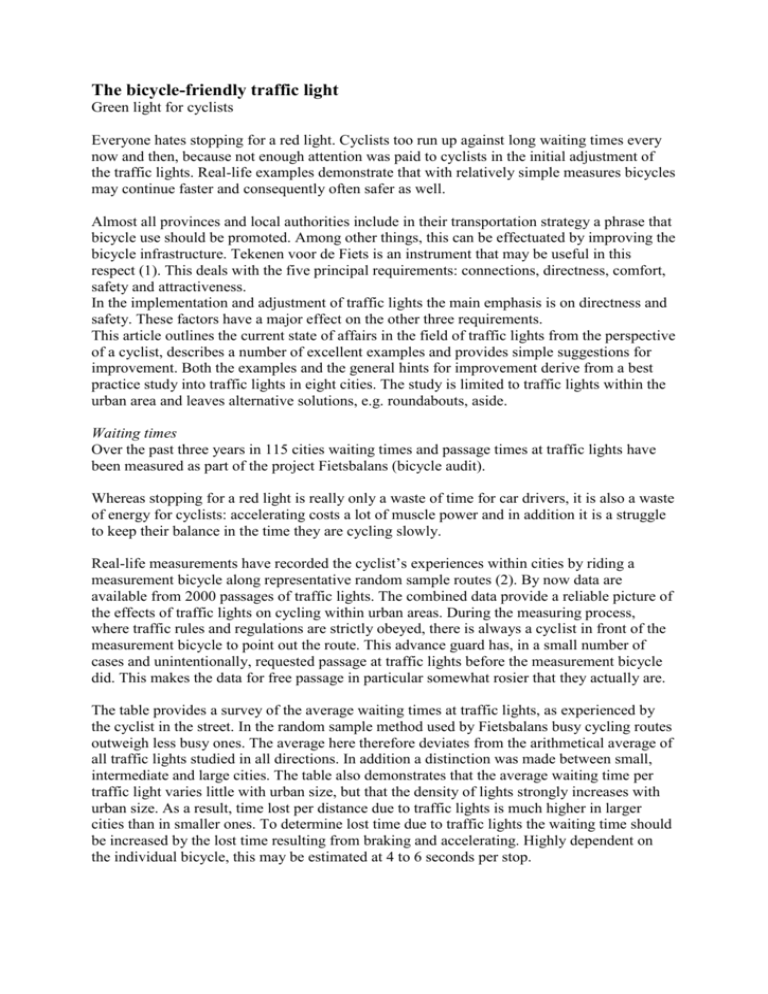
The bicycle-friendly traffic light Green light for cyclists Everyone hates stopping for a red light. Cyclists too run up against long waiting times every now and then, because not enough attention was paid to cyclists in the initial adjustment of the traffic lights. Real-life examples demonstrate that with relatively simple measures bicycles may continue faster and consequently often safer as well. Almost all provinces and local authorities include in their transportation strategy a phrase that bicycle use should be promoted. Among other things, this can be effectuated by improving the bicycle infrastructure. Tekenen voor de Fiets is an instrument that may be useful in this respect (1). This deals with the five principal requirements: connections, directness, comfort, safety and attractiveness. In the implementation and adjustment of traffic lights the main emphasis is on directness and safety. These factors have a major effect on the other three requirements. This article outlines the current state of affairs in the field of traffic lights from the perspective of a cyclist, describes a number of excellent examples and provides simple suggestions for improvement. Both the examples and the general hints for improvement derive from a best practice study into traffic lights in eight cities. The study is limited to traffic lights within the urban area and leaves alternative solutions, e.g. roundabouts, aside. Waiting times Over the past three years in 115 cities waiting times and passage times at traffic lights have been measured as part of the project Fietsbalans (bicycle audit). Whereas stopping for a red light is really only a waste of time for car drivers, it is also a waste of energy for cyclists: accelerating costs a lot of muscle power and in addition it is a struggle to keep their balance in the time they are cycling slowly. Real-life measurements have recorded the cyclist’s experiences within cities by riding a measurement bicycle along representative random sample routes (2). By now data are available from 2000 passages of traffic lights. The combined data provide a reliable picture of the effects of traffic lights on cycling within urban areas. During the measuring process, where traffic rules and regulations are strictly obeyed, there is always a cyclist in front of the measurement bicycle to point out the route. This advance guard has, in a small number of cases and unintentionally, requested passage at traffic lights before the measurement bicycle did. This makes the data for free passage in particular somewhat rosier that they actually are. The table provides a survey of the average waiting times at traffic lights, as experienced by the cyclist in the street. In the random sample method used by Fietsbalans busy cycling routes outweigh less busy ones. The average here therefore deviates from the arithmetical average of all traffic lights studied in all directions. In addition a distinction was made between small, intermediate and large cities. The table also demonstrates that the average waiting time per traffic light varies little with urban size, but that the density of lights strongly increases with urban size. As a result, time lost per distance due to traffic lights is much higher in larger cities than in smaller ones. To determine lost time due to traffic lights the waiting time should be increased by the lost time resulting from braking and accelerating. Highly dependent on the individual bicycle, this may be estimated at 4 to 6 seconds per stop. Compared to waiting times for traffic lights other causes of delay in large cities are negligible. The traffic light density within the three groups of urban area may differ widely. A quarter of all large cities has a traffic light density below the average for intermediate cities. Comfort Not only is waiting at traffic lights deemed uncomfortable, but also the actual stopping itself. Whereas stopping for a red light is really only a waste of time for car drivers, it is also a waste of energy for cyclists: accelerating takes a lot of muscle power and moreover it is a struggle to keep their balance while riding slowly. Both drawbacks become the more manifest when a cyclist carries a lot of baggage or transports a passenger. A common phenomenon is the mother with children in front and in back, having the greatest difficulty to keep the bicycle upright and get started again after a stop. Increasing passage chances at traffic lights may therefore considerably improve comfort. Due to the high density of traffic lights in the majority of large cities, the number of stops per kilometre there is much higher than in smaller cities. Stopping chances are also closely related to the manoeuvre the cyclist makes at the intersection (turn of continue ahead), as shown by Figure 1. At left turns cyclists have to stop most often. In itself hardly surprising, but it is possible to greatly facilitate this manoeuvre by specific measures. Traffic safety Officials often have highly theoretical ideas on traffic safety. Traffic lights are generally adjusted in such a way that on paper the most dangerous situations are prevented. In actual practice, however, accidents are mainly caused by ignoring red lights, both by cyclists and car drivers. Consequently intersections regulated by traffic lights are often less safe than expected. The problem is that safe solutions on paper may prove to be implausible in practice. A good example is an intersection where a partial conflict occurs between cyclists going straight ahead and cars making a right turn. After the minimum green time has passed, cyclists are faced with a red light while there are few cars making a right turn. Another example is that with very long waiting times for cyclists even the most law-abiding citizen will cross, convinced that the detection system is faulty. Long waiting times at traffic lights also generate extra accidents on adjoining non-regulated intersections. School children, for example, avoid traffic lights on a large scale, and cross arterial roads at dangerous locations. To obtain an effective traffic light regimen the five principal requirements for bicycle infrastructure should therefore not be isolated, but be integrated. Good examples Last year a list was compiled of the bicycle-friendly traffic lights that had been implemented. The cities that had been investigated by Fietsbalans and local branches of Fietsersbond have been invited to send in bicycle-friendly examples. From 30 entries 17 locations in eight different cities were selected demonstrating various good solutions. These locations were visited and investigated after an interview with the responsible official. The findings have been detailed in a report (3). The solutions ranged from quite simple and generally applicable to less simple and more specific to main bicycle routes in particular. Although these measures are somewhat more expensive and may increase cycle times, they do provide cyclists the quality befitting main bicycle routes. The intersections involved are used quite often by considerable numbers of cyclists (see box Good examples). Explanations The interviews with the various cities also revealed why traffic lights are not always adjusted in a bicycle-friendly way. The most obvious reason, viz. an intersection is so busy that more adjustments for bicycles are simple not feasible, appears to occur only rarely. Even at quiet intersections cyclists often wait unnecessarily long. left straight ahead right passage chance (%) 1. Passage chances for each direction urban size number traffic lights/km small intermediate large 689 708 605 0.33 0.61 0.99 waiting time lights at stop (sec) 33.4 33.3 29.4 % of total waiting time during trip 66 62 87 Table. Average values at traffic lights as measured by Fietsbalans, arranged by size of city: small = 20,000 - 50,000 inhabitants, intermediate = 50,000 - 100,000, large >100,000 inhabitants. Explanations for this phenomenon: - cyclists do not get a green light at times when there are no conflicting flows; - cyclists do not get a green light when they are registered during a green window; - cyclists do share the burden of the bus (VECOM-VETAG) arrangements, but do not profit (piggybacking with a green light for the bus); - the bicycle intensity has had no or only a minor role in the design of the traffic light schedule. The design process focuses first of all on optimal flow of motor vehicles. The other modalities are only plowed into the schedule on second thought. Often cycle intensities can play no role at all as these are not known, not even an approximation; - dynamic systems react insufficiently to bicycles. Quite often cycle times are lengthened when the number of cars increases, whereas a larger number of bicycles has no effect at all. The number of bicycles is either not recorded or there is no feedback to the control box; - there is a difference between a design on paper and the schedule in actual practice. In most intersections investigated the schedule in practice deviates from the design as provided by the authorities. The actual programming is often left to the supplier. The official responsible not always checks in practice whether the lights work as intended; - there is often a lack of time. Often a single official has to deal with too many intersections. Therefore no action is undertaken unless complaints are filed. Only rarely will official ‘spontaneously’ look for opportunities to make existing lights more bicycle-friendly; - the technical possibilities - especially in older lights - are limited. The major advantage of all bicycles together green over the standard two-phase green arrangement is that there are no longer any conflicts between cars making turns and cyclists going through. A red traffic light with no conflicting traffic often leads to red light negation. Solutions The survey of the various solutions has yielded five simple measures that are cheap and barely affect the passage of motor vehicles. 1. Always provide a green phase for cyclists when there is no conflicting traffic. An inspection on the street shows far too many lights do not meet this requirement. A derivative is the measure to provide immediate green to cyclists that are registered during an existing green window. 2. Arrange automatic piggybacking on request. If cars going straight through get a green light and there are no right-turning cars nor cyclists going straight ahead, bicycles still get a green light. In this way bicycles arriving somewhat later at the light may then pass immediately. This should be accompanied by automatic piggybacking in lengthening: cyclists have a green lights as long as the cars driving straight ahead do. In conflict-free arrangements this occurs quite frequently already, but usually not in the case of partial conflicts with (right) turning motor vehicles. Certainly in cases with a limited number of cars making turns this leads to an implausible arrangement and therefore to red light negation. Average waiting time and stops Average waiting times at traffic lights may mean one of two things that should be clearly distinguished. Usually in literature the average waiting time is meant to be the average over all cases where people actually had to stop. This is the waiting time as experienced by those involved as waiting time. It is however advisable to refer to this as ‘average waiting time when stopped’. To calculate the actual average waiting time at traffic lights all cases should also be taken into account where people could pass without stopping (waiting time: 0 sec.). 3. Use VECOM/VETAG in a smart way. Cyclists may often piggyback along with parallel driving buses. It should moreover be possible to adjust the lights in such a way that cyclists do not have to wait for a bus that does not cross their path. 4. Install detection loops at a distance of approximately 20 metres from the halt line and use these for both requests and lengthening. Often this is not done out of a fear of so-called false requests, cyclists turning between the loop and the light. In Delft, where this measure is often taken, 15% false requests is still deemed acceptable. Detection well in advance of the halt line improves both speed and comfort and is extremely suitable in accentuating a through bicycle route. 5. Regularly (at least twice a year) check on the street whether the lights still function satisfactorily. It may be that the lights no longer function according to the specifications issued originally. Or else the use of the intersection has changed in such as way that the lights are no longer optimal. Even though this may be deduced from mechanical counting data, traffic is a street affair. Looking on the street may be time-consuming, but is essential in designing and maintaining good traffic lights. Conclusion In particular in urban areas traffic lights are responsible for almost all delays of the cyclist. In regular traffic lights simple measures may provide many extra advantages for cyclists without affecting the flow of cars. Principal bicycle routes require more efforts to realise qualitatively high-grade solutions. Traffic light systems with twice green for cyclists per cycle and special attention to leftturning bicycles may contribute considerably to the passage and safety of bicycles, while increasing waiting times for cars only slightly. References 1. Anonymus, Tekenen voor de Fiets, Ontwerpwijzer voor fietsvriendelijke infrastructuur, CROW, Ede, 1993. 2 Boggelen, O. van and R. Becht, Gemeentelijk fietsbeleid langs de meetlat, Verkeerskunde 9/2001 3. Haan, D. de Maak uw VRI fietsvriendelijk, NHTV/Fietsersbond, Utrecht, 2002. In short - Often little attention is paid to cyclists and the specific situation of an intersection in designing traffic lights. - Various surveys have provided explanations and solutions for bicycle-(un)friendly light systems. - Even simple measures may allow traffic lights to take cyclists more into consideration, without affecting cars. Good example 1 Immediate priority for registered cyclists location: Haarlem, Parklaan intensities per 24 h: 12,000 motor vehicles, 5000 bicycles (data 1990) Haarlem had a problem familiar to many other cities: due to priorities for buses cyclists faced waiting times that could stretch to over two minutes. This led to an implausible light schedule, and remarkably often caused red light negation. To remedy this, a remarkable measure was introduced: cyclists being registered will have a green light at the next opportunity. However, this is accompanied by a number of restrictions aimed at limiting waiting times for intersecting traffic, among which prevention of a double stop for motor vehicles. The introduction of the new regime led to a reduction of the average waiting time for cyclists during peak hours by 30%, in off-peak hours even by 50%. Good example 2 Twice green per cycle for the principal bicycle route location: Tilburg, Heuvelring-Spoorlaan intensities per 24 h: 28,000 motor vehicles, 12,5000 bicycles A common situation: a major bicycle route intersecting a busy arterial road where a multilevel solution is impossible. In Tilburg such a bicycle route at the edge of the town centre crosses a busy east-west connection, also used by a large number of buses. Without any additional measures the maximum waiting time would be almost two minutes. This would be far too long for the cyclists on the busy principal north-south bicycle route. Consequently these cyclists have twice as often a green light as the other traffic participants. The maximum waiting time is thereby reduced to a little over a minute, the average waiting time is half a minute. Thanks to this measure the average waiting time was reduced by 50% and the maximum waiting time with 30%. On the other hand, the cycle time had to be lengthened by approximately 10 seconds, causing the average waiting time for motor vehicles to increase by approximately 15%. Good example 3 All cyclists together twice green in the same cycle location: Enschede (two intersections) intensities per 24 h: up to 25.000 motor vehicles, 9000 bicycles The all cyclists together green arrangement used in Enschede is even more bicycle-friendly than the previous examples. Cycle time is much shorter here (60-90 seconds compared to 90120 seconds in Tilburg), making the average and maximum waiting times shorter as well. This advantage affects both cyclists and motor vehicles. Extra advantages include the fact that left turns have become easier for cyclists thanks to the diagonal crossing and that a single request causes all bicycle traffic lights to give green. In addition to this arrangement, cyclists also have a green light twice in the same cycle. This is necessary anyhow, to prevent the presence of too many cyclists at the intersection itself during a green phase, which might cause problems among cyclists themselves. In comparison with the standard two-phase schedule this has the major advantage of preventing conflicts between lorries and cars making a turn and cyclists going straight through. These conflicts are in actual practice much more serious than conflicts among cyclists, as opponents of this arrangement argue. Now that mopeds no longer use bike paths, these intersections seldom cause problems among cyclists in actual practice. All cyclists together green in combination with twice in the same cycle green provides to cyclists average and maximum waiting times during peak hours of 20 seconds and 40 seconds, respectively, with a passage chance of 15 per cent without any double stops for cyclists turning left.
